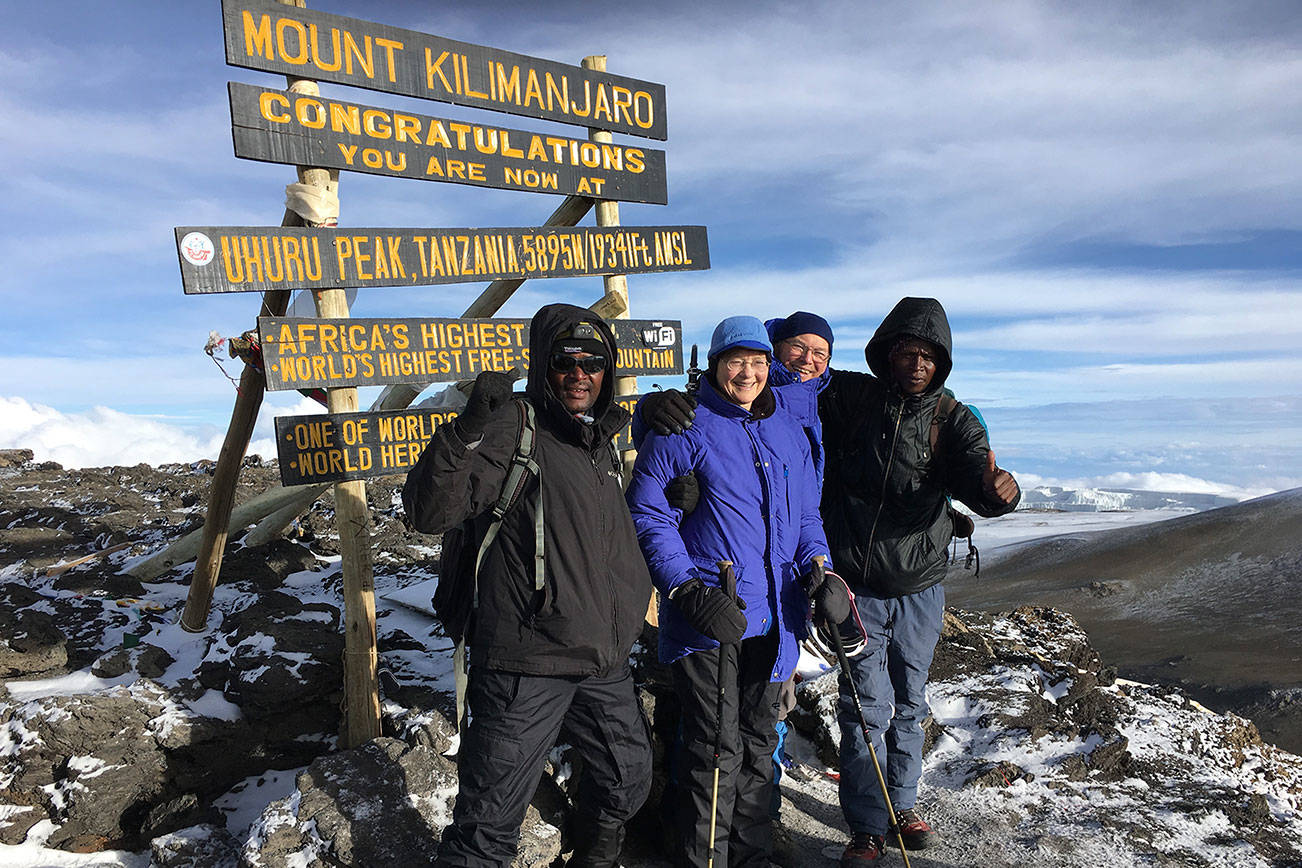Editor’s note: This first installment of the 2019 Traveler’s Journal series — “Kilimanjaro: Trekking to the Rooftop of Africa,” by Steve and Lucy Nordwell — was postponed from Feb. 14 because of winter weather and was rescheduled for April 11. — MD
Traveler’s Journal
When: 7 p.m., Thursday, April 11
Where: Guy Cole Convention Center, 202 N. Blake Ave.
Cost: Suggested $5 donation (adults); 18 and younger, free
Presenters: Steve and Lucy Nordwell
Presentation: ‘Kilimanjaro: Trekking to the Rooftop of Africa’
By Steve Nordwell
For the Sequim Gazette
In February 2018, we left from the Seattle airport on the first leg of our journey to Arusha, Tanzania. Our ultimate objective: Mount Kilimanjaro, the highest point on the African continent. We were in the air for about 25 hours, making stops at JFK in New York and at Doha, Qatar.
Mount Kilimanjaro, a dormant volcano with an elevation of 19,341 feet, is almost 5,000 feet taller than our Mount Rainier. We planned our climb for the end of the dry season and spent seven days on the mountain: five-and-a-half days up and one-and-a-half days down. It’s possible to do the climb in fewer days, but we chose to do a longer trip in order to get used to high altitudes and decrease the chances for altitude sickness which could have prevented us from reaching the summit. The oxygen level at the top is only half that at sea level, and we were told that the success rate for reaching the summit is 65 percent.
Mount Kilimanjaro has five distinct climate zones. Starting at 80 to 90 degrees (Fahrenheit) in the rain forest, we ascended until we hit the alpine desert, then continued up to the Arctic zone, where the summit temperature is 10 to 15 degrees F. The entire hike is about 37 miles long, but it is the elevation that is key. Most days we would ascend a few thousand vertical feet.
Climbing Mount Kilimanjaro is a big tourist attraction in Tanzania. You are required to hire a guide and a company to escort you up the mountain, so we were well-cared for, including three square meals a day in our own dining tent. They also provided our tents and sleeping bags.
After the second night, we awoke to frost on the tents each morning. This is at a location that is only 200 miles south of the equator. We had rain, hail and snow most afternoons, but while hiking during the day it was clear.
On the night of the summit attempt, we woke to clear skies and, with headlamps and a full moon lighting our way, we began the final ascent. It was sunny when we reached the top, with a light dusting of snow.
We had a grand view of the remaining glaciers, and the size of the summit crater was impressive as we walked around it on the crater rim. We reached the summit just after sunrise, on the first day of March 2018.
Lucy and I are fortunate to find ourselves retired and in good health. We try to always have an adventure in the planning stages. In 2015, we hiked the 500-mile Camino de Santiago across northern Spain, and in 2017 we did the same thing in Portugal.
Without Lucy, I climbed volcanoes in Oregon and California last spring, and in January I will be in Ecuador to climb three volcanoes there — one of which is even 1,000 feet taller than Mount Kilimanjaro.
About the presenters
Steve Nordwell was born and raised in the Sequim and Port Angeles area. After graduating from the University of Washington in chemical engineering, he married Lucy from his high school graduating class, and they had a brief stint living on the East Coast.
In 1978, Steve returned to the Olympic Peninsula to begin his 40-year career in the pulp and paper industry.
Now retired in Port Angeles, he and Lucy spend much of their time traveling and enjoying outdoor activities. They credit their interest in Europe and Africa to teachers from high school who taught Spanish, German and Afro-Asian Studies.
About the presentations
Traveler’s Journal is a presentation of the Peninsula Trails Coalition with local adventurers sharing their stories and photos with you. All of the money raised is used to buy project supplies and food for the volunteers working on the Olympic Discovery Trail.
Admission is $5 adults, youths 18 and under free. Shows start at 7 p.m. at the Guy Cole Event Center at Carrie Blake Community Park, 202 N. Blake Ave.
Each year the dream of a continuous trail from Port Townsend to Forks gets a little closer. In 2017, about 200 volunteers put in more than 9,000 hours of labor on the trail.
One selected photo enlargement will be given each week as a door prize.
Call Arvo Johnson at 360-301-9359 for more information.



